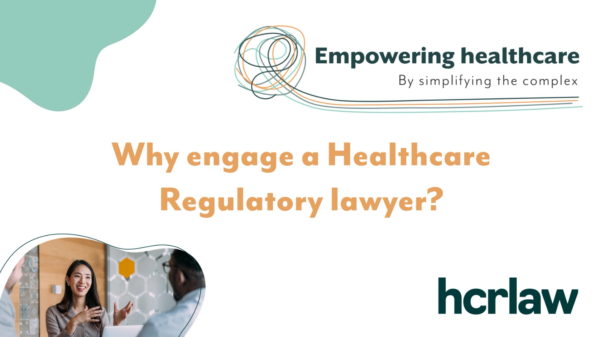
Preparing for and dealing with CQC inspections under the new Single Assessment Framework
2 July 2024

Healthcare Regulatory Partner at HCR Law, Laura Shelton, offers insight into how providers can prepare for and deal with assessments and inspections under the CQC’s new single assessment framework.
After a number of delays and teething troubles, the CQC’s new single assessment framework is now well underway.
This new regime has brought dramatic change to the way in which CQC inspects, scores and rates service – but keeping on top of the changes has not been easy for providers.
This article looks to break down some of the changes, explore some of the latest updates from CQC and offer some practical advice on preparing for and dealing with inspections.
Quality statements
One of the main changes under the new framework is that 34 quality statements replace the Key Lines of Enquiry, which are used to guide and direct their inspections. These Quality Statements identify the different areas considered under each of the five key questions, which have remained the same.
CQC is not prescriptive about what must be done in order to meet the quality statements; instead it provides the following six evidence categories which it will focus on. These are:
- People’s experiences
- Feedback from staff and leaders
- Feedback from partners
- Observation
- Processes
- Outcomes.
Providers should note that at least three of the evidence categories set out above relate to feedback.
Therefore, the first practical tip to prepare for good outcomes under the new framework is for providers to seriously consider overhauling the way they gather, record, share and act upon feedback from all stakeholders.
Think outside the box on this, gather feedback pro-actively and regularly, and ensure you can present it in a meaningful way to the CQC. Then, ensure you link that good feedback into another of the evidence categories – outcomes. Evidence how your care has produced good outcomes, perhaps with mini case studies.
Infection control – quality statement
The CQC recently announced that historic infection prevention and control (“IPC”) detail is being removed from their website as they are no longer using the same inspection model. In new assessments this area will be looked at under its own quality statement.
Ratings and scoring
Whilst the CQC’s current ratings of ‘Outstanding’, ‘Good’, ‘Requires Improvement’ or ‘Inadequate’ remain in place, CQC is now using a scoring framework to determine the quality of the service. Depending on what it finds, a score will be provided for each required evidence category. This will be combined with evidence category scores to give a score for the related quality statement. Initially they will only publish ratings but in the future they intend to publish specific scores.
The scoring system is a big change and it is not entirely straightforward. Accordingly, a good way to prepare for inspection is to ensure you are familiar with and understand the scoring system. The CQC very recently produced a video on how scoring features in its assessment model which can be accessed here.
Our further tips to ensure the best outcomes under the new inspection framework are:
Before the inspection
- Keep up-to-date on the changes to CQC guidance and get familiar with them. Examine each quality statement and find evidence in your service to highlight how you meet it. For the best ratings include evidence of innovation, continuous improvement and sustainability challenge your own systems as part of quality assurance and audit to check for weaknesses against the CQC quality statements. Make a plan to address any weaknesses and evidence how you have implemented and embedded it
- As above, feedback is key: gather feedback from all stakeholders, review it and most importantly – act upon it!
- Ensure staff are familiar with what to expect from a CQC inspection. Provide training on how to speak to inspectors and reassure them to be confident about this.
During the inspection
- Ask questions, offer assistance and request feedback throughout to avoid surprises
- Provide outstanding information and ensure you address any immediate compliance issues that arise during the inspection promptly
- Request feedback and make notes; it is very easy to forget what has been said under the pressure of inspection.
After the inspection
- Supply any additional evidence that CQC requests promptly and comprehensively
- Ask for clarification about issues that you are unclear about
- Respond in detail to the draft inspection report. This is your one chance to challenge inaccuracies within the report and ratings
- You may wish to seek legal advice and assistance with the factual accuracy process. We have assisted numerous providers to remove negative language and regulatory breaches from draft report as well as securing improved ratings. Bear in mind the deadline set – usually 10 working days – and ensure you seek advice promptly.
Re-inspection timeframes – when will CQC be back?
There was a time when CQC’s provider handbooks set out clear timelines under which services could expect to be re-inspected based on their existing rating.
As we moved through the pandemic the focus of inspections shifted towards risk-based inspection rather than timetabled ones based on existing ratings. At that time the re-inspection timeframes were removed from published CQC guidance.
Thus far, the roll out of the Single Assessment Framework has not included any detail for providers on inspection frequencies. This has been a huge concern for providers, especially those rated ‘Requires Improvement’, many of whom have been waiting years to be re-inspected.
CQC are due to publish detail on this imminently and are currently seeking views on how frequently they will assess providers going forward. Providers can, and should, contribute here.










